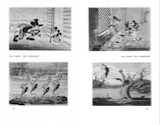
The animated cartoon, youngest of art forms, has an ancestry that leads back to hieroglyphics and the drawings of cave men. So far has the egocentric, self-conscious trend in easel painting traveled from the simple beginnings of art as a means for thought communication and the chronicling of events that the film is today a more direct lineal descendant of primitive art than the latest in the abstract.
The animated cartoon also carries into the realm of the actual as against that of illusion the pet theory of Cézanne and his followers who would produce in paint the semblance of bodily movement. Figures in the animated cartoon do not seem to move; they do move, and the process is carefully analyzed by draughtsmen through innumerable drawings, giving precise changes and building up the physical sequence of the merest step. Add color to this study of line in action, and there opens a fascinating vista of almost unexplored possibilities that transcend the more rigid limitations of other art media. A picture is conceived not as one "still" on canvas but as a progression of scenes that in the aggregate develop emotional magic. This view of an art medium is not wholly nevel. While the film is a new and potent tool, the idea of cartoon sequence is as old as man's own history. Its ancestors may be found in such complex collaborative art gestures as the paintings of historical, social, and religious episodes on walls and floors of ancient Egyptian palaces and temples, or in the Biblical sequences carved in stone on cathedrals of the Middle Ages. […]